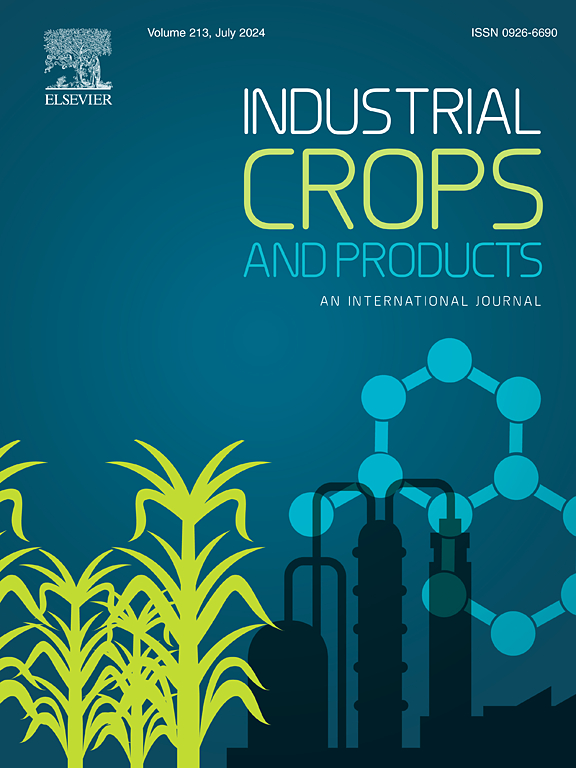花青素积累对杜鹃花瓣斑点着色的影响及其药用价值
IF 6.2
1区 农林科学
Q1 AGRICULTURAL ENGINEERING
引用次数: 0
摘要
杜鹃花是一种著名的本土植物,具有观赏、食用和药用等多种用途。在其众多的性状中,花瓣斑点是其观赏价值的重要组成部分。然而,调控杜鹃花斑点着色的成分和潜在的分子机制仍不清楚。在这项研究中,我们进行了综合代谢组学和转录组学分析,以阐明杜鹃花青素生物合成途径,该途径在花瓣的不同颜色组织(斑点和背景)之间被不同的激活。黄酮类化合物是雷克斯红花花瓣中最丰富的代谢物;与背景对照物相比,花青素、花青素3,5-二- o -葡萄糖苷(花青素)、花青素3- o -葡萄糖苷(菊花)和飞鸽苷等花青素在斑点区显著富集。这些发现表明花青素主要有助于斑点色素沉着。值得注意的是,在野生杜鹃花中罕见的具有抗氧化特性的天龙苷衍生物在雷克斯杜鹃花瓣中被鉴定出来,这表明雷克斯杜鹃具有潜在的药用价值。转录组学数据显示,CHS、CHI、F3’5’h和DFR的上调,以及HCT和FLS的下调,促进了花瓣斑块中花青素的积累。此外,CHS和HCT联合调控类黄酮和木质素的生物合成,DFR和FLS联合调控花青素和黄酮醇的生物合成,表明通过调节结构基因表达来应对参与植物某些次生代谢物生物合成的共享前体的竞争,从而维持代谢平衡。此外,bHLH、MYB、WRKY、bZIP等关键转录因子与花青素生物合成的调控相关。该研究通过揭示rr . rex独特的代谢产物和调控途径,为木本植物花瓣斑点形成提供了新的见解;这些研究结果为进一步研究雷克斯龙的药用成分和治疗潜力奠定了基础。本文章由计算机程序翻译,如有差异,请以英文原文为准。
Anthocyanin accumulation underlies petal blotch coloration in Rhododendron rex and its medicinal potential
Rhododendrons are prominent indigenous plants recognized for their various applications owing to the ornamental, edible and medicinal properties. Among their diverse traits, the petal blotches significantly contribute to their ornamental value. However, the components and underlying molecular mechanisms regulating rhododendron blotch coloration remain poorly elucidated. In this study, we performed integrative metabolomic and transcriptomic analyses to elucidate the anthocyanin biosynthesis pathway in Rhododendron rex, which is differentially activated between the contrasting colored tissues of the petals (blotches versus backgrounds). Flavonoids were identified as the most abundant metabolites in R. rex petals; anthocyanins such as pelargonidin, cyanidin 3,5-di-O-glucoside (cyanin), cyanidin 3-O-glucoside (chrysanthemin), and delphinidin were significantly enriched in the blotch regions when compared to the background counterparts. These findings indicate that anthocyanins primarily contributed to blotch pigmentation. Notably, pelargonidin derivatives with antioxidant properties, which are rare in wild rhododendron flowers, were identified in R. rex petals, indicating the potential pharmaceutical value of R. rex. Transcriptomic data revealed that the upregulation of CHS, CHI, F3′5′H, and DFR, alongside the downregulation of HCT and FLS, promoted anthocyanin accumulation in the petal blotches. Furthermore, the combined regulation of flavonoid and lignin biosynthesis by CHS and HCT, as well as that of anthocyanin and flavonols by DFR and FLS, demonstrates that the metabolic balance is maintained through the regulation of the structural gene expression in response to competition for shared precursors involved in the biosynthesis of some secondary metabolites in plants. Moreover, key transcription factors, including bHLH, MYB, WRKY, and bZIP, are correlated with the regulation of anthocyanin biosynthesis. This study provides novel insights into the blotch formation of petals in woody plants by revealing unique metabolites and regulatory pathways in R. rex; moreover, these study outcomes establish a foundation for further research on the medicinal constituents and therapeutic potential of R. rex.
求助全文
通过发布文献求助,成功后即可免费获取论文全文。
去求助
来源期刊

Industrial Crops and Products
农林科学-农业工程
CiteScore
9.50
自引率
8.50%
发文量
1518
审稿时长
43 days
期刊介绍:
Industrial Crops and Products is an International Journal publishing academic and industrial research on industrial (defined as non-food/non-feed) crops and products. Papers concern both crop-oriented and bio-based materials from crops-oriented research, and should be of interest to an international audience, hypothesis driven, and where comparisons are made statistics performed.
 求助内容:
求助内容: 应助结果提醒方式:
应助结果提醒方式:


